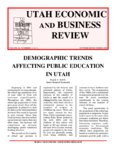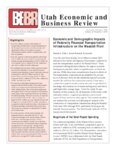TO
| Title | Date | Subject | Description | ||
|---|---|---|---|---|---|
| 26 |
 |
Statistical Abstract of Utah 1973 | 1973-02 | The Bureau of Economic and Business Research presents the sixth edition of the Statistical Abstract of Utah, 1973. The basic goal of this document is to bring together under one cover the data most often requested in a readily available format. During an average year, government agencies, business f... | |
| 27 |
 |
1976 Statistical Abstract of Utah | 1976-01 | The Bureau of Economic and Business Research presents the seventh edition of the Statistical Abstract of Utah, 1976, the Bicentennial Edition. The basic goal of this document is to bring together under one cover the data most often requested in a readily available format. During an average year, g... | |
| 28 |
 |
The changing composition of the State budget | 1976-04 | An issue of vital concern to all taxpayers and administrators of government is the distribution of state revenues from the various accounts to the departments of state government. A detailed account of the growth and changing patterns of state expenditures from 1969 to 1975 is presented in this issu... | |
| 29 |
 |
Estimates and projections of low income population in Utah 1970-1985 | 1977 | This i s one in a series of projections and estimates of "target populations" defined by the Utah Department of Social Services for planning, management, and budgeting purposes. The fourteen target populations are: | |
| 30 |
 |
Critical issues in Utah's future: volume II | 1977-02 | ||
| 31 |
 |
Age and sex population projections for Utah counties: 1975-2010 | 1978-06 | ||
| 32 |
 |
Uped model revision report on completion of work item I contract for services | 1978-10-05 | This report is submitted in completion of Work Item I of the referenced contract between the State Planning Coordinator's Office (SPCO) and the Bureau of Economic and Business Research, University of Utah (BEBR). The report is in two sections: The first section presents the narrative discussion of t... | |
| 33 |
 |
UPED79 Report on revisions of the Utah process economic and demographic impact model (UPED) | 1980-01 | This report describes the Utah Process Economic and Demographic Impact Simulation Model (UPED) and the computer soft ware that implements it as they have been developed and refined as of February, 1980. The acronym UPED79 refers explicitly to the refinements to the model and its software which were ... | |
| 34 |
 |
Energy development in the Uintah Basin: economic and demographic impacts | 1981-07 | This report, "Energy Developments in the Uintah Basin: Economic and Demographic Impacts," is one of aseries of reports issued by the State Planning Coordinator's Office that are designed to support comprehensive planning and the development of a Utah growth management strategy. The report is intende... | |
| 35 |
 |
The economic & demographic impacts of the intermountain power project | 1982-04 | This report presents economic and demographic projections for the two-county (Millard and Juab) area to be impacted by the Intermountain Power Project located in western Millard County, Utah. The intermountain Power Agency has been planning the construction of the IPP project for quite some time. | |
| 36 |
 |
Utah Statistical Abstract 1983 | 1983 | The Bureau of Economic and Business Research presents the ninth edition of the Statistical Abstract of Utah, 1983. The basic goal of this document is to bring together the data most often requested in a readily available format. During an average year, hundreds of calls and personal visits are made... | |
| 37 |
 |
1984 baseline projections executive summary | 1984-09 | ||
| 38 |
 |
Abridged life tables for males and females: Utah and its planning districts, 1980 | 1985-10 | ||
| 39 |
 |
1986 baseline projections | 1986-06 | ||
| 40 |
 |
1987 baseline projections | 1987-04 | ||
| 41 |
 |
Baseline scenario 1997 | 1997-09 | ||
| 42 |
 |
Baseline scenario 1998 | 1998-02 | ||
| 43 |
 |
Demographic trends affecting public education in Utah | 2000-11 | Beginning in 2004 and continuing for at least a decade, the school age population (5 to 18 year olds) in Utah will increase significantly. Throughout the 1990s, the school age population in Utah grew more slowly than did the population in general so that its share in the total population declined. T... | |
| 44 |
 |
State of Utah economic and demographic projections: 2000-2030, 2000 baseline highlights | 2001-01 | ||
| 45 |
 |
State of Utah economic and demographic projections: an analysis of the accuracy of UPED's historical projection work | 2001-04-01 | ||
| 46 |
 |
Revised Utah population estimates for the 1990s | 2001-05 | Every 10 years, the U.S. Bureau of the Census conducts a population count. In the intervening years the Utah Population Es timates Committee (UPEC) annually prepares total resident population estimates for each of the 29 counties in the state. These estimates are based on methods that ut i l i z e s... | |
| 47 |
 |
The coming boom in Utah's school age and college age populations: state and county scenarios | 2002-09 | Population analysts have for some time anticipated a significant increase in the school age population (5 through 17 years of age) of Utah beginning around 2004 and extending for at least a decade. At this point the question is not whether the boom will materialize, but rather, the exact timing, mag... | |
| 48 |
 |
Economic, demographic and fiscal impacts of closing Hill Air Force Base: a statewide and regional analysis | 2004-04 | The upcoming round of Defense Base Closure and Realignment (BRAC) is threatening the existence of Hill Air Force Base (Hill AFB). The Department of Defense is aggressively approaching this round of BRAC in its attempt to eliminate 20% to 25% of current capacity. The purpose of this study is to asses... | |
| 49 |
 |
Immigrants transform Utah: entering a new era of diversity | 2004-05 | Utah is generally perceived as an extremely homogeneous state whose population can trace its ancestry mostly to northern Europe. Listings for surnames like Hansen, Jensen, and Christensen do fill many pages in local telephone directories throughout the state. According to census counts, the minority... | |
| 50 |
 |
Economic and demographic impacts of federally financed transportation infrastructure on the Wasatch Front | 2004-09 | Over the next three decades, $14.4 billion (constant 2004 dollars) of new transit and highway infrastructure is planned to meet the transportation needs of the Wasatch Front.1 These investments will significantly influence the region's economic development potential, relative competitiveness, and la... |
